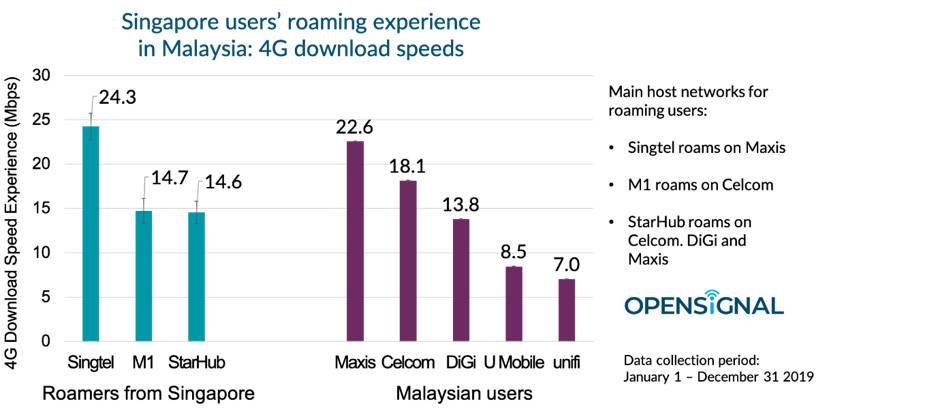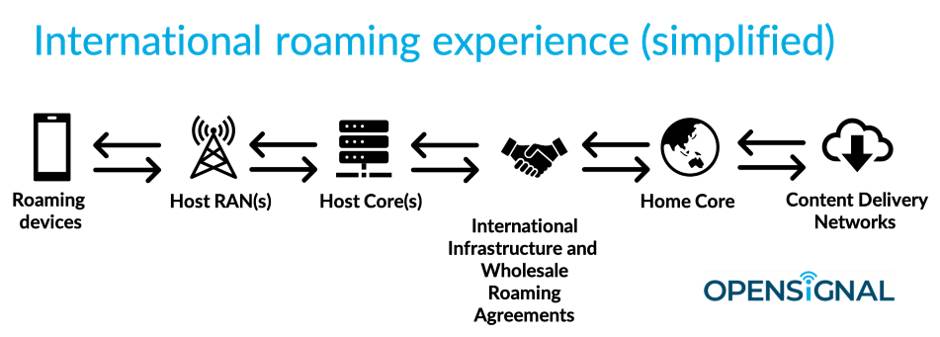How Singaporeans’ Roaming Experience in Malaysia is Affected by their Choice of Operator
By: Sam Fenwick, Insights Analyst, Opensignal
In this analysis we look at how three measures of the mobile user experience — Download Speed Experience, Upload Speed Experience and Latency Experience — vary between international roamers from Singapore and domestic users in Malaysia. We analyzed the roaming experience of those 4G users that travelled from Singapore to Malaysia during 2019.
When roaming in Malaysia we found that out of Singapore’s main operators, Singtel users enjoyed the best Download Speed Experience, Upload Speed Experience and Latency Experience. M1 and StarHub users had a similar Download and Upload Speed Experience when in Malaysia, but StarHub users moved ahead of M1 in their roaming Latency Experience.

There is a degree of correlation between the Download Speed Experience observed by a roaming user and that observed by domestic Malaysian users on the same host network. This is most pronounced when comparing the Download Speed Experience observed by Singtel roamers and domestic Maxis users, and less so when comparing M1 roamers against domestic Celcom users. With the latter, there’s a speed reduction of roughly 3.4 Mbps in favor of Malaysian Celcom users. This difference could be caused by a number of factors, such as the international connectivity between the two networks, the terms of the roaming agreement, another kind of bottleneck or even some form of throttling on roaming users that is affecting M1 users’ Download Speed Experience when roaming on Celcom’s network.
Out of the three Singaporean operators, Singtel users observed the highest Download Speed Experience when roaming in Malaysia. There is little difference between the experience observed by M1 and StarHub roaming users.
Moving onto the Upload Speed Experience, once again Singtel users observed the fastest speeds on average when roaming in Malaysia, while those on M1 and Starhub were comparable. As was the case with Download Speed Experience, the speeds observed by M1 roamers were lower than those seen by Celcom domestic users, this time by approximately 1.6 Mbps.

We now turn to Latency Experience (a measure of network responsiveness). This is likely to be adversely affected by international roaming given the extra steps that it entails, such as the need to reach the home operator’s core network. Singtel customers observed the lowest (and therefore best) Latency Experience, compared with roamers from Singapore on its competitors’ networks.

We also found that the average Latency Experience observed by Singtel users when roaming in Malaysia is only 2.6ms worse than that seen by domestic Maxis users. This indicates good international connectivity between Maxis and Singtel’s networks because a lower Latency Experience score represents less delay.
In contrast, both StarHub and M1 users observed latencies that were considerably slower than those seen by domestic Malaysian users, indicating a worse experience. The Latency Experience seen by M1 users was nearly double that seen by Celcom’s domestic users (74.5ms versus 39.4ms, a difference of 35.1ms), while the average Latency Experience seen by StarHub users (55.1ms) was greater than that seen by Celcom, DiGi and Maxis users by 15.7, 12.8 and 17.2ms, respectively.
We’ve shown that Singtel users see the best experience when roaming in Malaysia for these three measures of the mobile network experience when compared to users of other Singaporean operators. We also found that the roaming mobile experience is complex: latency doesn’t always increase markedly when roaming; one operator’s users may use more than one network when abroad; and the difference between roaming experience can vary across different measures of mobile network experience.
Operators typically have roaming agreements with one or more host networks, allowing their customers to roam on them while abroad. We detected that when in Malaysia, Singtel users typically roam on Maxis, M1 users most often roam on Celcom and StarHub users normally roam on Celcom, DiGi and Maxis.
Finally, If you’re curious as to how international roaming works, here’s a simplified diagram:

Because of the way in which international roaming works, differences in the average mobile experience observed between roamers and domestic users may arise due to differences in the mix of mobile devices they’re using and the locations where they spend most of their time (as the mobile experience is typically superior in urban areas). There’s also the potential impact from the additional latency and potential bottlenecks created by having to relay the information between host and home core networks and between the home core and the content delivery networks. For more on how international roaming works, see the GSMA’s guide to this topic.

Zero Visibility is now available at Kinokuniya Books Singapore and Maywell Lifestyles @ Dempsey 13 Dempsey Rd, Singapore


